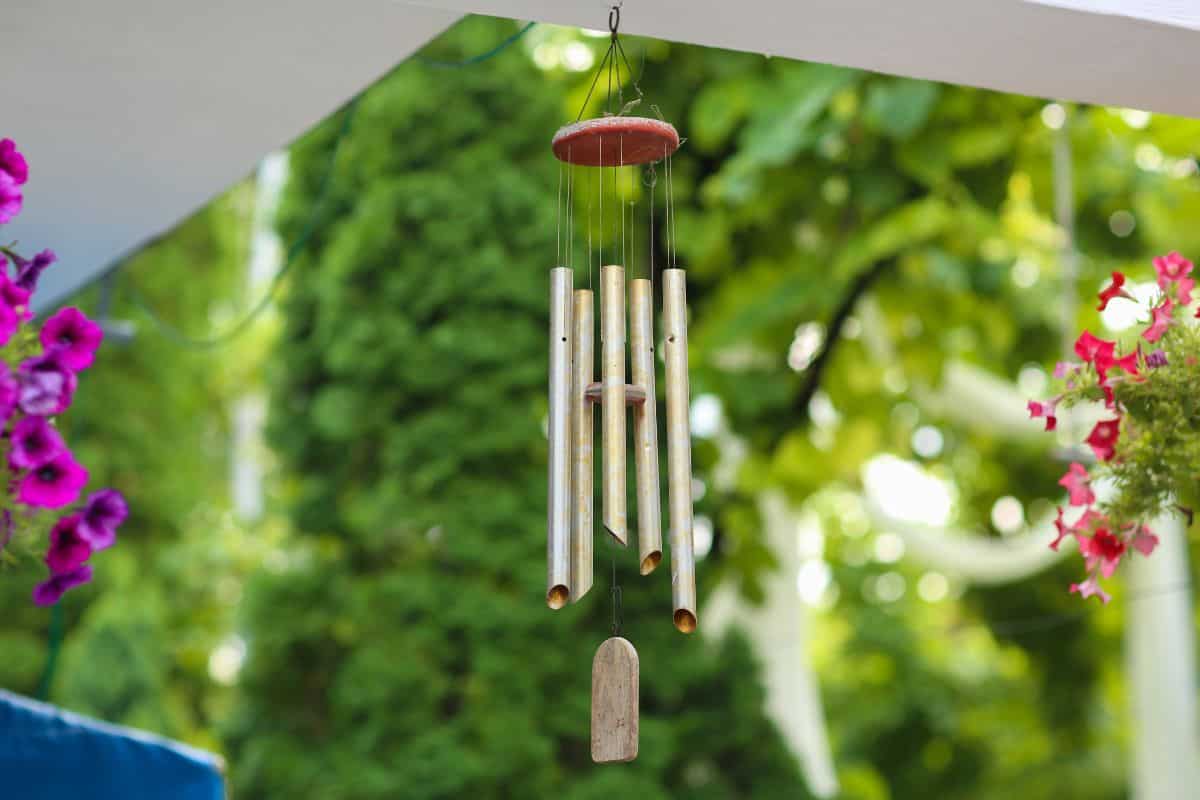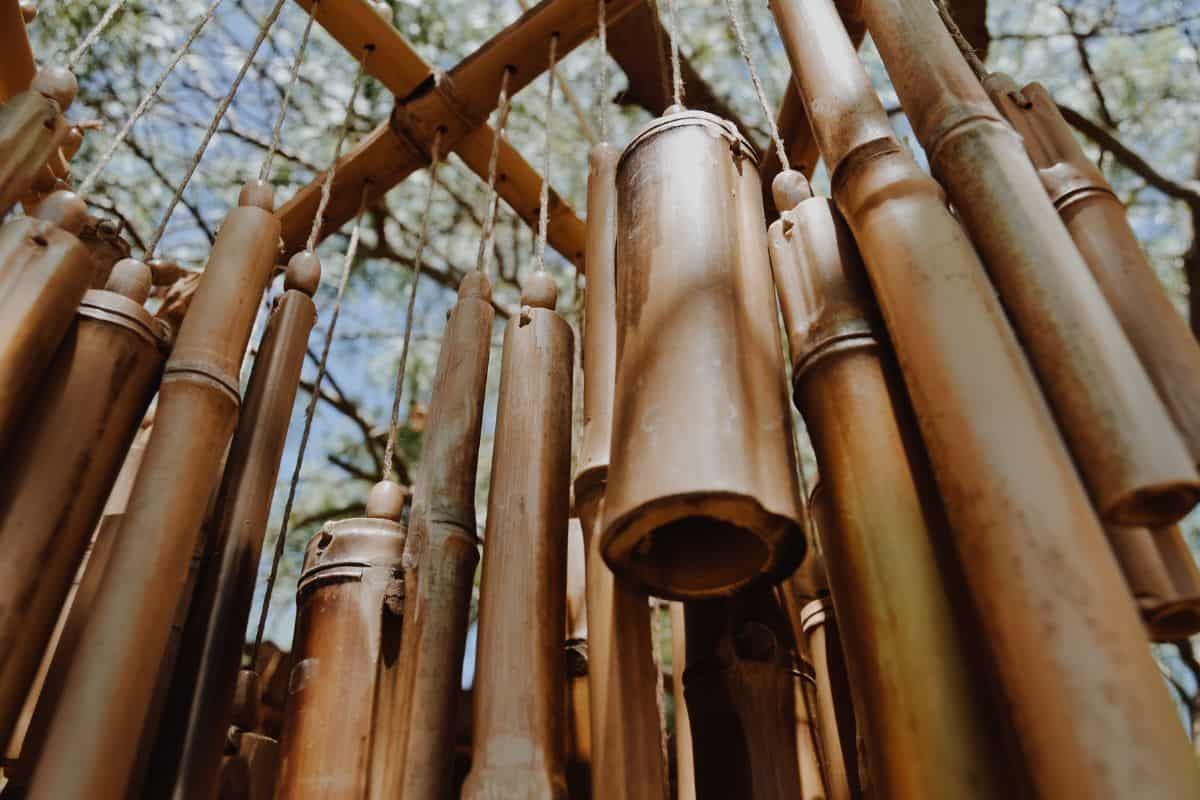Aside from the music they bring, wind chimes can add style to outdoor and indoor spaces and bring calm to your surroundings. If you want to create wind chimes for your home or garden but are unfamiliar with the suitable measurements, don't worry. We've researched this topic for you.
The span and dimensions of wind chime pipes will impact the tone the chimes produce. To make short to medium wind chimes that play a five-note pentatonic scale, you can use this guide:
- C9: 6.5-inch pipe
- C8: 9.18-inch pipe
- C7: 13-inch pipe
- C6: 18.9-inch pipe
- C5: 26-inch pipe
There are various factors to note when making wind chimes, such as materials, types of pipes, and the steps to follow. Keep reading to learn more about these details and everything you need to know about wind chimes.
Length And Tones For Your Chimes
Wind chimes come in various colors, materials, and sizes. A precise cut of pipe for your wind chime will result in a perfect melody.

Length determines the sound or note a pipe produces. Short pipes ring with high treble notes, while long pipes reverberate with bass notes.
Typically, a wind chime has a five-note scale or pentatonic tone. With this scale, you can make a chime that will produce a relaxing, pleasurable sound.
Making Chimes With A Five-Note Scale
- A short wind chime pipe produces a soaring sound. To make your own set of wind chimes, you will need a pipe that's 1.5 inches wide. You will need to cut it into precise lengths. Here are the measurements:
- 6.5-inch metal tube for a C9 note
- 9.18-inch metal tube for a C8 note
- 13-inch metal tube for a C7 note
- 18.9-inch metal tube for a C6 note
- 26-inch metal tube for a C5 note
Click here to see these wind chime aluminum tubes on Amazon.
How To Assemble Wind Chimes

Making your own wind chimes at home can be an exciting DIY project. All you need to do is prepare your materials and tools and follow the instructions below.
Materials And Tools To Use
- Metal tubes or pipes: Metallic pipes like copper, aluminum, and steel are common materials in making wind chimes.
- Synthetic cord or nylon: The cord needs to hold your chimes securely. It should be sturdy enough to support your wind chimes as a whole.
See this black nylon wind chime cord on Amazon.
- Wooden striker: A striker or clapper is a block positioned in the middle of the chimes. When the pipes make contact with it, they produce vibrations which cause sounds.
- Wooden suspension platform: You will need to cut a round platform that's larger than the striker. It will hold the chimes and allow them to hang.
- Rectangular or round piece of wood: This wood is the sail that dangles from the clapper. It should hang lower than the pipes so that it can sway with the wind and cause the striker to move, creating sound.
- Pencil
- Drill
- Pipe Cutter
- File or sander
Steps in Making DIY Wind Chimes

Here are the easy-to-follow steps for making your own wind chimes:
- Mark the center of your round suspension board with a pencil. Mark eight points around the edge of your platform at an equal distance from the center. You should also make marks on the other side of the base to determine where you will drill holes.
- Secure the base to your worktable and drill through the center and the points you marked earlier.
- Run the nylon cord through the sail and the striker, and then tie it. Tie another knot for the striker, making sure it hangs about 16 inches above the sail.
- Connect the striker to the suspension platform. Take the string on top of the clapper and thread it through the center hole of the base. Securely tie the cord on top of the platform.
- Using a pipe cutter, cut the pipe in the lengths mentioned earlier for a small to medium chime.
- With a sander or file, sand the edges of the tubes to eliminate sharp ends.
- Drill a hole in the top portion of the pipes so you can thread the chimes on the base.
- Securely knot each chime about 3/4 inch below the base.
Types Of Wind Chimes
While relaxing in your garden or on your porch, the sound from wind chimes is calming. Different wind chimes make different sounds. Read on to learn about the various types of wind chimes.
Bell Chimes
Instead of tubes, bell chimes use hanging bells. This type produces a clinking sound as the wind blows out the bells. Bell chimes are frequently placed in windy areas and indicate harsh weather is approaching.

Decorative Chimes
Decorative chimes come in vibrant colors and designs. You can place them indoors. They are delicate and are not suitable to put in open areas.
Tubular Wind Chimes
This kind of wind chime has tubular-shaped metal like aluminum and copper. It creates a smooth, soothing sound that is perfect for gardens and outdoor areas. Tubular wind chimes are the most common type and come in various dimensions.
Memorial Chimes
This wind chime is an excellent gift choice with a unique engraving feature. People use memorial chimes in special events such as embracing new periods.
Click here to see these memorial wind chimes on Amazon.
Feng Shui Chimes
This type of chime is believed to bring wealth, prosperity, and good energy to your home. Feng shui chimes often feature Chinese designs.
See these feng shui wind chimes on Amazon.
Bamboo Chimes
Bamboo chimes expel bad energy and bring tranquility. When blown by the wind, bamboo chimes create a relaxing, dreamy sound. They are great for indoor and outdoor use.
Click here to see these bamboo wind chimes on Amazon.
Best Placement For Wind Chimes

According to Vastu, an approach to design and architecture from ancient India, proper placement or hanging of wind chimes in specific locations is essential.
Different chimes have different benefits and must be placed or hung in their corresponding areas for effectiveness.
Metal Chimes
Wind chimes made of metal like copper, aluminum, and bronze are believed to enhance mental precision and draw fortune and prosperity to your household.
If you place the chimes on the west side of your home, they will inspire innovation and boost your children's welfare. When you place your metal chimes in the northwest, your chimes will draw kind people to you.
Wooden Chimes
Wooden chimes like bamboo bells increase fitness, energy, promotion, and abundance. You can hang your bamboo chimes in the east, south, or southeast.
If you place them in the east, they will reinforce your well-being and prosperity. If you put wooden bells in the south, they will attract fortune.
Clay or Porcelain Chimes
Clay or porcelain chimes should be placed in the center of your home, where they can attract prosperity. They are ideal for hanging in the northeast, southwest, and southeast.
When you place your ceramic chimes in the northeast, they will draw intelligence and success. If you hang them southwest, they will bring intimacy and connection.
You should hang your chimes close to the main door to your house to allow good energy to enter. Keep your chimes two feet away from furniture, objects, and walls.
Final Thoughts
Creating your own wind chimes can be a fun DIY project. You can hang your finished chimes in your garden or your home. Some people believe that wind chimes draw good fortune and expel evil spirits.
Make sure to read and take note of the lengths discussed in this post, as well as the proper directions for hanging your wind chimes.
If you found this post helpful, check out these related articles:
Do Wind Chimes Keep Hawks Away?
21 Unique Gifts For Gardeners.






i cut my own pipe. where can i find or order longer lengths of pipe for wind chimes. it can be thin Al pipe like conduate etc can be 4 feet or longer